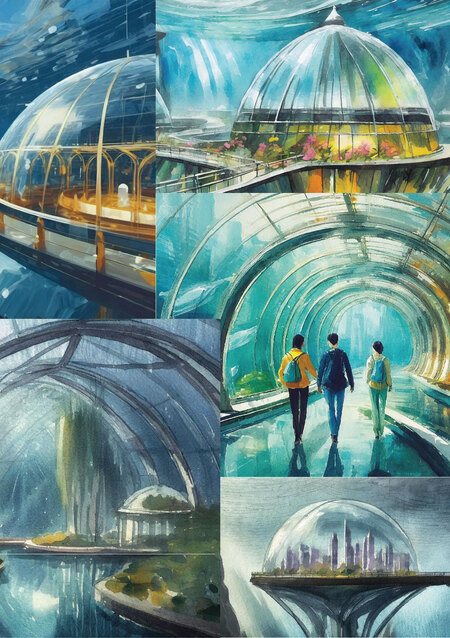
Project Abyssal Epoch Navigating Earth’s Future
Content
I. Survival under the waves II. References III. The emergence of underwater cities IV. The evolution of underwater cities V. Technological miracles VI. Future Challenges VII. Economy and operation VIII. Cultural diversity IX. Professions X. Future Scenarios XI. Vision of Harmony and Cooperation XII. Building a sustainable future
I. Survival under the waves
In the year 3000 and beyond, the Earth faces catastrophic overheating due to the destruction of the ozone layer. When temperatures soar, visionary scientists initiate Project Abyssal Epoch, constructing huge underwater glass domes to ensure humanity’s survival amid the encroaching environmental chaos.
II. References
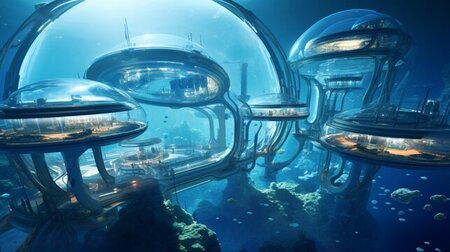
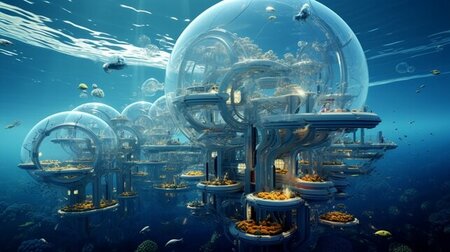
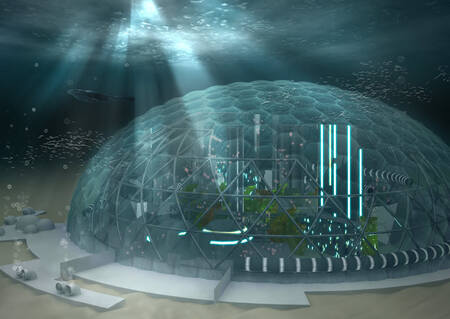
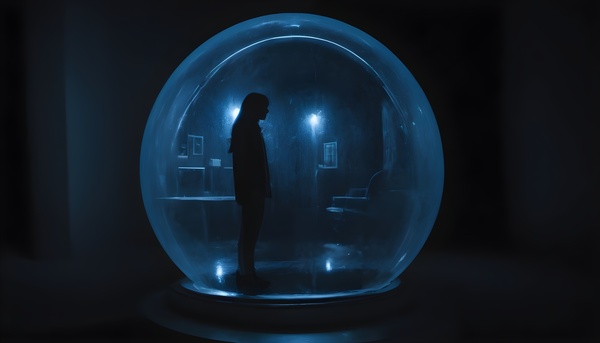
III. The emergence of underwater cities
In response to the escalating environmental crisis, scientists initiate the Abyssal Epoch Project, building the first underwater glass domes as a refuge from extreme surface conditions. These domes, originally intended as shelters, became into self-sustaining underwater cities integrating advanced aquaponics systems for food production. The construction process uses innovative engineering technologies to withstand the enormous pressure of the deep ocean and create an underwater habitat favorable for human life.
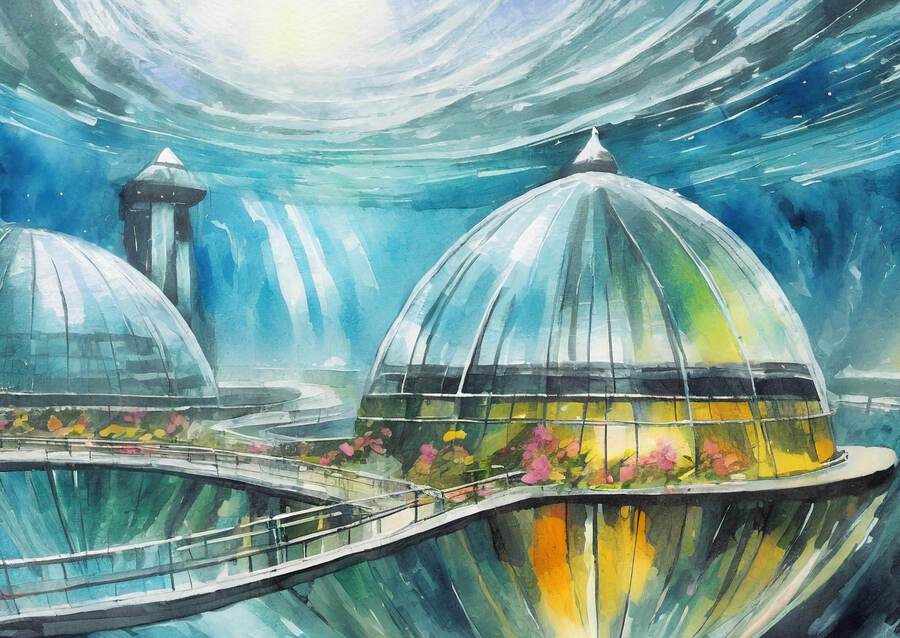
Author: Velovska Dona, watercolor.
IV. The evolution of underwater cities
Underwater communities undergo profound biological adaptations to thrive in perpetual darkness. Enhanced low-light vision and artificial bioluminescent sources allow for navigation, and genetic modifications increase resilience. Interconnected worlds are emerging, facilitating cultural exchange and resource sharing among underwater communities. Residents develop special diving suits and equipment to explore the depths of the surrounding ocean, allowing scientific research and resource collection outside the glass domes.
Author: Velovska Dona, watercolor.
V. Technological miracles
Advances in water filtration, sustainable energy, and waste management ensure self-sufficiency and sustainability of underwater habitats. Artificial intelligence systems optimize the use of resources, and current adaptation strategies are aimed at solving external environmental problems. The development of advanced robotics and autonomous drones is helping to perform maintenance tasks outside of domes, such as like repairing infrastructure and monitoring marine life.
Compensation for the lack of sunlight in the underwater city is carried out through the use of artificial bioluminescent sources. They are carefully tuned to mimic the circadian rhythms needed to maintain circadian rhythms and mental well-being among residents. Additionally, advanced aquaponics systems introduce innovative lighting techniques to support the growth of marine life in glass domes. These measures ensure that a balanced environment is maintained, promoting a sustainable lifestyle, despite the lack of natural sunlight.
Author: Velovska Dona, watercolor.
VI. Future Challenges
As populations grow, underwater cities must balance the needs of their inhabitants with the ocean’s limited resources. Ethical dilemmas related to genetic modification, resource allocation and environmental protection require careful consideration and resolution. Debate has arisen regarding the ethics of genetic engineering, with some advocating increasing human ability to adapt to underwater environments, while others express concerns about potential unintended consequences and impacts on biodiversity.
Author: Velovska Dona, watercolor.
VII. Economy and operation
The underwater city’s economy operates on the principles of sustainability and self-sufficiency, and the aquaponics systems run on renewable energy sources. Trade agreements with surface communities facilitate the exchange of resources, ensuring mutual survival and prosperity. Underwater cities are becoming hubs of innovation, attracting scientists, engineers and entrepreneurs eager to develop new technologies and solutions for sustainable living both underwater and on the surface.
Author: Velovska Dona, watercolor.
VIII. Cultural diversity
Cultural diversity thrives under the glass domes, reflecting the past and experiences of underwater inhabitants. Educational initiatives promote innovation and empower people to face the challenges of underwater existence. Community events and festivals celebrate the rich cultural heritage brought by residents from diverse backgrounds, fostering a sense of unity and belonging among the undersea inhabitants.
IX. Professions
Professions in the underwater city include aquaculture, environmental research, infrastructure maintenance and artistic expression. Each person plays a vital role in the collective effort to thrive in this flooded refuge. Residents are offered specialized training programs and educational opportunities that enable them to develop skills and knowledge tailored to the unique challenges and opportunities that undersea life presents.
Author: Velovska Dona, watercolor.
X. Future Scenarios
Research into terraforming, space colonization, and advanced technology provide hope for the future. Collaboration between underwater and surface communities is driving innovation and expanding the boundaries of human knowledge. Underwater cities serve as models for sustainable living and inspire similar initiatives on the surface, promoting global cooperation and solidarity in addressing shared environmental challenges.
Robots do not play a significant role in this concept of underwater cities. Instead, the emphasis is largely on human adaptation, ingenuity, and cooperation to thrive in the underwater environment. While advanced technology is used to maintain infrastructure and manage resources, the narrative emphasizes sustainability and the ingenuity of human communities, rather than dependence on robots.
XI. Vision of harmony and cooperation
The story culminates in a shared future built on mutual respect and stewardship of the planet. While challenges remain, there is hope and optimism for continued survival and prosperity amid adversity. The success of underwater cities is inspiring a paradigm shift in human consciousness, leading to a re-evaluation of humanity’s relationship with the natural world and a renewed commitment to environmental conservation and sustainable development.
Author: Velovska Dona, watercolor.
XII. Building a sustainable future
Increasing investment in renewable energy, global cooperation and diversity are helping to create a future in which humanity lives in harmony with the natural world, valuing and protecting the planet for future generations. Collaborative research initiatives between the undersea and surface communities are focused on developing innovative solutions to address climate change, biodiversity loss and other pressing environmental challenges facing the planet.



